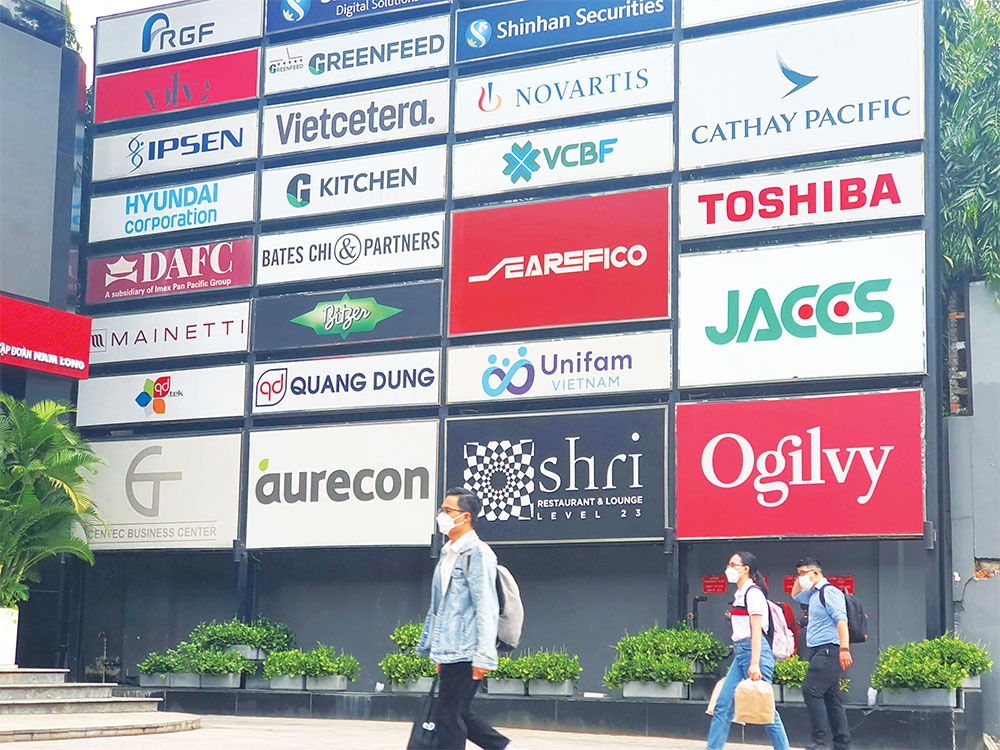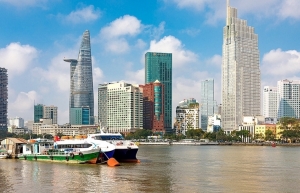Office lease activity trending towards non-business districts
 |
| Ho Chi Minh City is set to soon welcome about 60,000 sq.m of new office space, Le Toan |
According to Colliers, the office leasing segment in Vietnam is gradually recovering with the majority of demand coming from businesses looking to expand and new international companies entering the market.
The supply of Grade A office space is extremely scarce in the central areas of Hanoi and Ho Chi Minh City due to a lack of land fund, Colliers said.
In the coming time, the rental price and absorption rate of the whole office market is expected to increase sharply, thanks to the reopening of international routes and the strong resurgence of the non-central office market. Supply from projects in new urban areas will be a fresh choice for businesses in the context that supply of office space in central business districts (CBDs) is increasingly scarce and rents are increasing.
Pham Duy Khanh, a representative of lease group Nice Office in Ho Chi Minh City said, “Moving out of CBDs is being favoured by small- and medium-sized enterprises. Renting an office in Binh Thanh, Phu Nhuan, District 4, District 7, or Tan Binh is quite affordable for the needs of such businesses.”
Khanh said that in these areas, with offices equivalent to the level of comfort compared to offices for rent in District 1 or District 3, the rental price will be 10-30 per cent lower.
Moreover, currently, thanks to convenient transport infrastructure, it is easy to move from the suburbs to the city centre. It takes only 10 minutes to travel from Phu Nhuan, Binh Thanh, or District 4 to the city centre.
In non-CBD areas, many office buildings are newer and have modern facilities and equipment. “If the location is not a top priority, then businesses should consider choosing non-CBDs offices to optimise operating costs,” Khanh said.
Figures from Savills Vietnam reported that the average monthly rent for a Grade B building is currently at $34 per sq.m and $60 per sq.m per month for grade A office space.
In recent years, the supply of offices for lease is scarce and the demand for office space in Ho Chi Minh City and Hanoi has always remained high, so rents still tend to increase despite the market being burdened with many difficulties.
According to Savills, the Ho Chi Minh City area alone will welcome about 60,000sq.m of new office space, mostly from non-CBD areas of Tan Phu district and District 7.
In the central area, businesses are also tending to open more back-office areas or move offices to places near the centre such as districts 2 and 7, to reach their customers and partners quickly.
For example, the OfficeHaus office project in the centre of Celadon City, Tan Phu will be known a new destination outside CBDs.
In addition, there are a number of prominent projects in District 7 such as UOA, Cobi, and CMC Creative Zone, which are also known as high-quality, high-tech office projects with affordable rental costs.
In Hanoi, meanwhile, the western area is being assessed as having the fastest growth rate currently.
In the future, most of the supply will be concentrated in the Starlake project area in Tay Ho district with about 300,000sq.m of office space, mainly in the A and B segments.
In addition to the actual rentals, businesses must allocate budgets for cleaning, parking, printing, and other operating expenses. However, this fee at an off-centre office is often cut significantly to the most optimal prices. As a result, businesses will be able to use their cut-off fess for improving business performance and employee satisfaction.
In the downtown area, the cost of living is mostly higher. For offices in non-CBD areas, a more affordable cost of living promises to bring many great advantages to businesses. For example, companies and investors in Saigon Hi-Tech Park can enjoy a number of incentives and attractive tax schemes.
In addition, office projects outside the centre often have the advantage of a large land fund, which can develop green areas to help employees feel relaxed and have more fresh air, creating a healthier working environment for employees.
In some other cases, Hoang Minh Hang, director of Star Investment and Property Leasing JSC, said that some businesses have stalled production and business activities and their revenue is affected, forcing them to narrow the office space to save costs or move to an area further from the centre.
“Moving to the outskirts is inevitable because the land in the central areas is scarce, and businesses not only save costs but also widened the radar of their business,” Hang said.
Representative offices of many foreign-led companies can now be found in provinces neighbouring Hanoi and Ho Chi Minh City, where many industrial zones have been developed. Accordingly, in addition to a head office in big cities, tenants are oriented to develop satellite offices in neighbouring areas to directly manage their business in the localities.
 | Office for lease in high demand The transformation of the office market and office occupiers' growing care to consider office occupancy costs were the key topics of a seminar held on September 27 in Ho Chi Minh City. |
 | Ho Chi Minh City suggests halving land lease tax for real estate companies Ho Chi Minh City People’s Committee has just submitted a proposal to the prime minister to introduce a range of supportive measures to help out the real estate market which has been strongly impacted by the coronavirus. |
What the stars mean:
★ Poor ★ ★ Promising ★★★ Good ★★★★ Very good ★★★★★ Exceptional
Related Contents
Latest News
More News
- Sun Group breaks ground on $2 billion Van Don casino complex (December 19, 2025 | 18:14)
- Rare, beautiful, sustainable: the mark of iconic real estate (December 19, 2025 | 08:00)
- Owner-occupied housing stabilises, paving the way for new growth cycle (December 18, 2025 | 17:04)
- Unlocking urban potential of smart cities (December 18, 2025 | 16:50)
- Green finance offers 'passport' for Vietnamese construction, building materials firms (December 15, 2025 | 08:00)
- Gamuda Land commit long-term investment (December 12, 2025 | 11:49)
- HITC ties up with Evolution to develop AI and hyperscale data centres in Vietnam (December 11, 2025 | 12:09)
- Real estate deals boom via high-profile names (December 08, 2025 | 11:32)
- Industrial segment shaped by M&As (December 08, 2025 | 08:00)
- The Privé sets the benchmark for luxury real estate (December 05, 2025 | 08:28)

 Tag:
Tag:




















 Mobile Version
Mobile Version